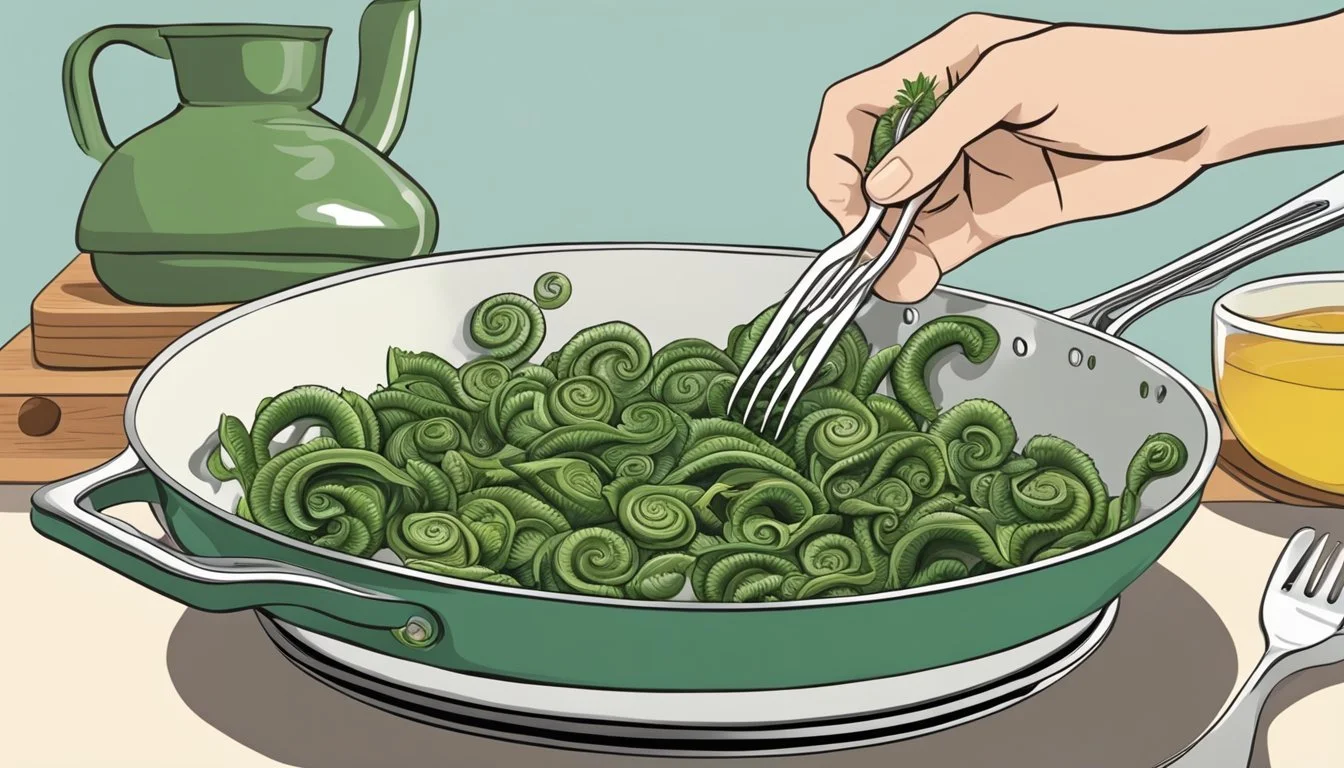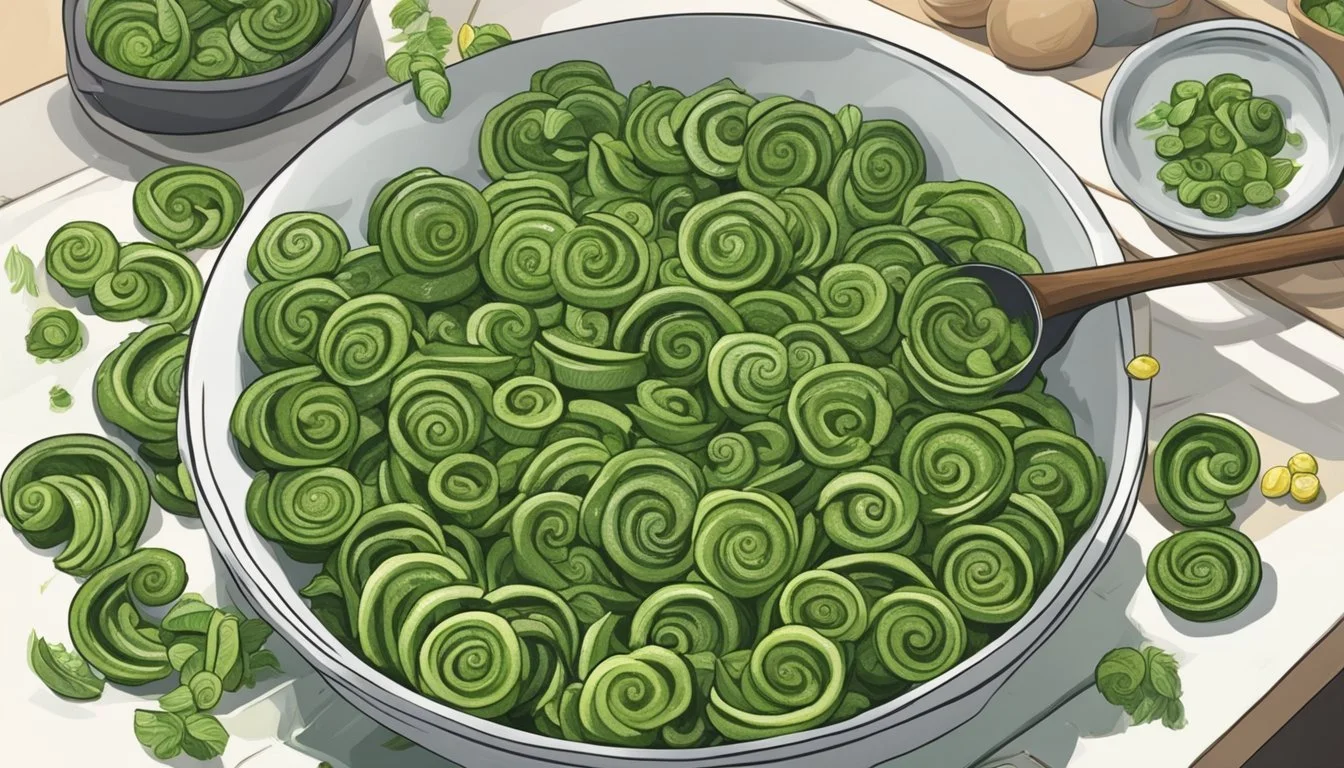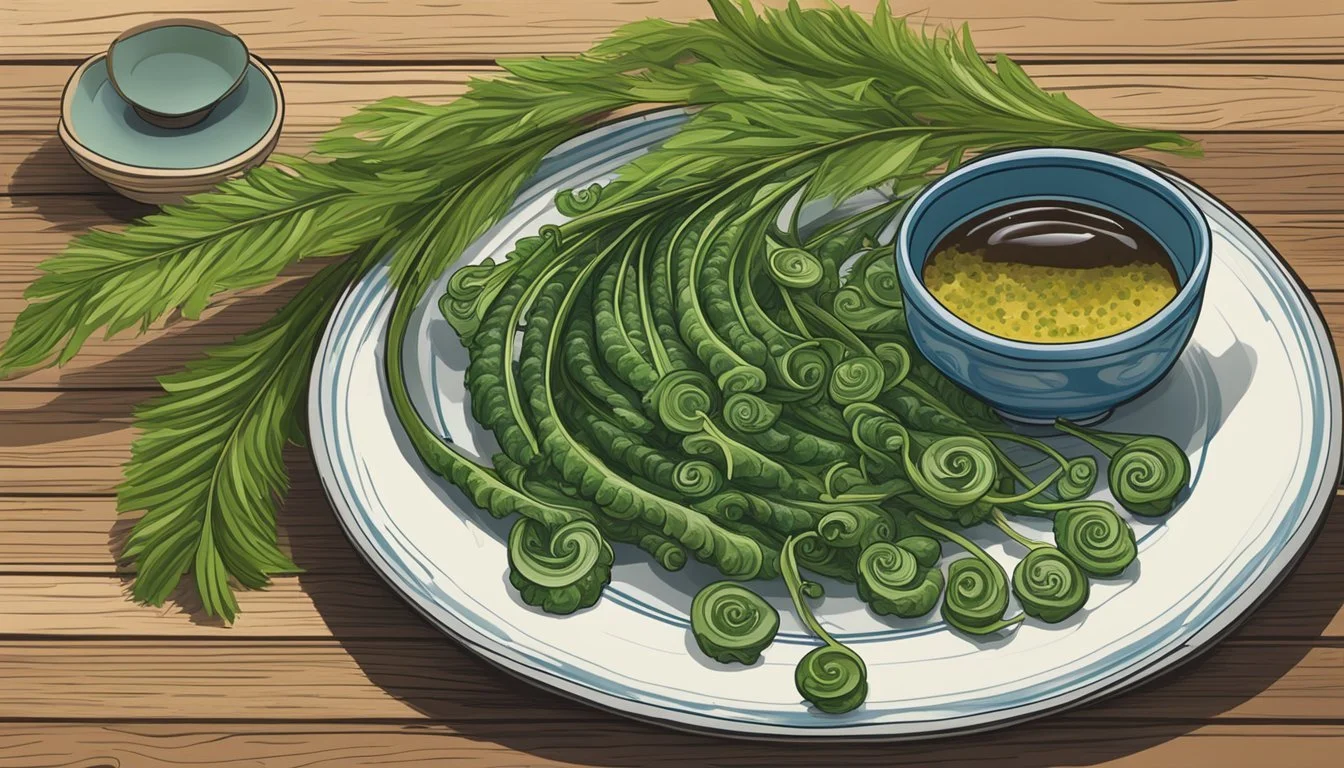How Do You Eat Fiddlehead Ferns
A Guide to Preparing & Enjoying This Spring Delicacy
Fiddlehead ferns are the furled fronds of a young fern, harvested for their unique flavor and texture. As a spring delicacy, these edible coiled shoots of the ostrich (What wine goes well with ostrich?) fern appear briefly in markets and are a popular foraged food. Recognizable by their tightly wound spiral shape that resembles the scroll of a violin, fiddleheads provide an earthy taste reminiscent of a cross between asparagus (What wine goes well with asparagus?), spinach, and young green beans.
To ensure fiddlehead ferns are safe to eat, proper preparation is crucial. They should never be consumed raw due to potential foodborne illness risks. The ferns must be thoroughly washed to remove any dirt and brown papery husk remnants. Cooking them is essential; boiling for at least five minutes or steaming for ten to twelve minutes is recommended to eliminate any bacteria or toxins. Once cooked, they can be sautéed lightly to enhance their flavor. Serving them alongside butter or olive oil can complement their natural, grassy notes.
Fiddlehead ferns' brief seasonal appearance and distinctive look make them a sought-after ingredient for enthusiasts looking to add a touch of spring to their plates. Whether incorporated into salads, pastas, or served as a side dish, fiddleheads bring a dynamic element both visually and on the palate. As they gain popularity, fiddleheads continue to be a testament to the breadth of edible plants available in the wild and the importance of seasonality in cuisine.
Identifying Edible Fiddleheads
When foraging for fiddleheads, one must be able to distinguish edible varieties such as the ostrich fern from other, potentially non-edible ferns. Correct identification and timing are crucial for safe consumption.
Distinguishing Ostrich Ferns from Other Ferns
Ostrich ferns (Matteuccia struthiopteris) are identifiable by certain key features. They have a u-shaped groove on the inside of their smooth, green stem, which is a distinguishing characteristic absent in other ferns such as bracken and lady ferns. The fiddleheads themselves are about one inch in diameter, tightly coiled, and covered with a brown, papery, scale-like covering. They should not be confused with lady ferns (Athyrium filix-femina) or bracken ferns, which may have similar appearances but lack the distinct groove of the ostrich fern.
Recognizing the Optimal Foraging Time
Fiddleheads refer to the young, coiled leaves of ferns, harvested for their unique flavor and texture. The best time to forage for ostrich fern fiddleheads is in early spring when they are just emerging from the ground and the coils are tight. During this time, the young fern is yet to unfurl its leaves, which makes it tender and suitable for consumption. Once the leaves open and the plant matures, the fiddleheads become tough and lose their characteristic appeal. Foragers should also be aware of their local environment's foraging regulations and sustainability practices to avoid overharvesting.
Health and Nutrition
Fiddlehead ferns are recognized for their rich nutritional profile, including being a source of vitamins and minerals while maintaining a low-calorie count. This section delves into the specifics of what makes fiddleheads a nutritious choice and addresses potential health risks associated with their consumption.
Nutritional Value of Fiddleheads
Fiddlehead ferns provide an impressive array of nutrients while remaining low in calories. A 100-gram serving contains roughly 34 calories, which makes them a lightweight yet nourishing food. They are particularly noted for their vitamin and mineral content:
Vitamin A: Essential for vision, immune function, and skin health.
Vitamin C: 44% of the daily recommended value, important for immune defense and collagen production.
Fiber: Provides about 10% of the daily requirement to promote digestive health.
Iron: A component crucial for blood production.
Antioxidants: Fiddleheads have a high antioxidant content, which helps in combating oxidative stress.
Omega-3 and Omega-6 Fatty Acids: These essential fats have a role in brain function and cell growth.
Nutrients Amount per 100 grams Calories 34 Fiber 10% of daily value Vitamin A 72% of daily value Vitamin C 44% of daily value Iron Significant amount Antioxidants High Omega Fatty Acids Present
Possible Health Risks
While fiddlehead ferns are nutritious, they may also pose health risks if not properly prepared. Consumers should be aware of the following:
Toxins: Raw fiddleheads may contain a toxin that can cause food poisoning.
Carcinogen: There is potential for a carcinogenic compound if fiddleheads are harvested from certain fern species.
Fiddleheads' Safety: It's essential to cook fiddleheads thoroughly to destroy any harmful toxins and reduce the risk of food poisoning. Blanched or sautéed fiddleheads are not only safe but also enhance flavor and digestibility.
In summary, fiddlehead ferns can be a healthy and nutritious addition to a diet when properly prepared, offering an array of vitamins, minerals, fiber, and antioxidants. However, adequate cooking is crucial to eliminate potential risks associated with their natural toxins.
Preparing Fiddleheads for Cooking
Before cooking fiddlehead ferns, one must ensure they are properly prepared. This involves cleaning, blanching, and potentially freezing for later use. Each step plays a crucial role in ensuring the fiddleheads are safe and pleasant to eat.
Cleaning and Trimming Methods
To begin, fiddleheads should be freed from any brown papery husk remnants and rinsed thoroughly in cold water to remove dirt and grit. They should be visually inspected, and the ends trimmed as needed. It is recommended to perform multiple rinses until the water runs clear to ensure complete cleaning.
Blanching Process
Blanching fiddleheads is essential for two reasons: it neutralizes any bitterness and it ensures safety by killing potential pathogens. To blanch, one should:
Bring a pot of salted water to a rolling boil.
Add the cleaned fiddleheads to the boiling water.
Let them cook for approximately 2 minutes, until they are bright green and tender but still crisp.
Immediately transfer the fiddleheads from the boiling water to a bowl of ice water to stop the cooking process.
Adding lemon juice to the boiling water can enhance the fiddleheads' vibrant color.
Freezing Technique for Preservation
For fiddleheads that won't be consumed immediately, freezing is an effective preservation method. After blanching, fiddleheads should be dried thoroughly on clean towels. They can then be wrapped in plastic wrap or placed in freezer bags and stored in the refrigerator's freezer compartment. This method helps retain their texture and green color for later use.
Cooking Techniques and Tips
Before diving into the specifics of cooking fiddlehead ferns, one must be aware that proper preparation is vital for both taste and safety. Cleaning the ferns thoroughly and ensuring sufficient cooking times are key factors in enjoying this unique seasonal vegetable.
Boiling and Steaming Methods
To begin cooking fiddleheads, one can either boil or steam them. Boiling entails bringing a pot of salted water to a rolling boil and then cooking the fiddleheads for about 10 minutes. It's essential to use about one to two teaspoons of salt per quart of water to help preserve their vibrant color and to mitigate any potential bitterness. Steaming requires less water, usually just enough to fill the bottom of the steamer. The fiddleheads are then steamed for a similar duration until they are tender yet still crisp, akin to the texture of green beans or asparagus.
Sautéing with Flavor Enhancers
Once the fiddleheads have been boiled or steamed, they can be sautéed to enhance their flavor. In a skillet, heat up a bit of melted butter or cooking oil on medium heat. Add cleaned fiddleheads to the hot pan and sprinkle with salt and pepper to taste. For extra flavor, consider adding minced garlic or shallots, akin to how one might sauté mushrooms or ramps. Sauté the ferns until they're gently browned, which usually takes about five minutes.
Incorporating Fiddleheads into Recipes
Fiddleheads make an exciting and flavorful addition to a variety of recipes. Their taste is often compared to a cross between spinach, asparagus, and artichoke. They can be folded into salads for a crunchy element or added to pasta dishes much like one would with green vegetables. To infuse their unique taste into a dish, consider adding pre-cooked fiddleheads to quiches, (What wine goes well with quiche?) omelets, or a creamy risotto during the final stages of cooking.
Serving and Pairing Suggestions
Fiddlehead ferns offer a gourmet experience with their grassy, spring-like flavor and crisp texture. They pair well with a variety of ingredients and can be elegantly presented to elevate any meal.
Complementary Flavors and Ingredients
Vegetables: Asparagus and green beans are excellent companions, sharing a similar verdant freshness.
Proteins: They complement the rich flavors of chicken, salmon, and steak beautifully.
Herbs and Spices: Garlic and ramps enhance the ferns' earthy tones, while pepper can add a subtle heat.
Citrus: A squeeze of lemon juice can brighten the dish and highlight the ferns' natural flavor.
Fats: Butter or a light vinaigrette melds seamlessly with their delicate taste.
Pairing fiddleheads with similar springtime vegetables like artichoke and spinach creates a harmonious blend, especially in salads. The umami flavors of mushrooms also make them a great pair for the ferns.
Presentation and Garnishing Ideas
Simple Elegance: Serve sautéed fiddleheads on a white platter with a lemon wedge garnish to accentuate their vibrant green color.
Rustic Charm: Present them in a ceramic bowl, perhaps mixed with sautéed asparagus, and sprinkle with finely chopped garlic for a touch of rustic appeal.
Salad Incorporation: Toss lightly cooked fiddleheads into salads for a twist on texture and flavor, dressed with a light vinaigrette.
Accents: Fiddleheads can be finely chopped and used as a garnish on dishes where mushroom or artichoke is the star.
In mindful pairing and presentation, one can showcase the unique characteristics of fiddlehead ferns, making them a standout addition to any dish.
Safety and Consumption Guidelines
Consuming fiddlehead ferns requires particular attention to food safety due to the potential risks associated with improper preparation. These guidelines ensure that enjoyment of fiddleheads does not compromise one's health.
Proper Cooking to Reduce Risks
Properly cooking fiddlehead ferns is essential to reduce the risk of foodborne illness. Raw or undercooked fiddleheads have been associated with reports of nausea, food poisoning, and other gastrointestinal complaints. To mitigate these risks, one should:
Thoroughly wash the fiddleheads in several changes of cold water to remove any dirt or debris.
Boil the fiddleheads in a generous amount of water for at least 15 minutes.
Alternatively, steam the fiddleheads for 10 to 12 minutes.
After cooking, discard the water used to prevent consuming any released toxins.
Understanding Consumption Limits
While fiddleheads are a nutritious vegetable, they contain natural compounds that can be toxic if ingested in large amounts. It's important for consumers to understand that these ferns should not be eaten in excess, and one should always adhere to recommended preparation methods to minimize potential health risks.
Natural Toxins: Fiddleheads may contain natural toxins and bitter compounds that can cause discomfort if not cooked properly.
Food Safety: Adhering to food safety guidelines is crucial as consuming raw or inadequately cooked fiddleheads may lead to symptoms akin to food poisoning.
Limits on Consumption: There isn't a precise, universally agreed-upon limit for fiddlehead fern consumption, but moderation is key. One should consume these ferns as part of a varied diet.
Sourcing and Sustainability
Sourcing fiddlehead ferns involves choosing between foraging for wild ferns or purchasing them from markets, with sustainability as a crucial factor either way. Responsible harvesting practices are essential to the health of wetland ecosystems where fiddleheads thrive.
Foraging versus Buying
Foraging for fiddleheads is a tradition in many regions during spring, a time when these spring edibles emerge. They should be foraged judiciously, typically in wetland habitats across Canada, the United States, Asia, and Europe. It's important for foragers to identify the correct species, as the ostrich fern is most commonly sought for its edible shoots.
In contrast, buying fiddleheads at farmers markets or specialty stores offers a consumer the assurance that they've been sourced correctly, albeit usually at a higher cost. The advantage is that buyers can directly support farmers and gatherers who practice sustainable harvesting.
Supporting Sustainable Practices
When opting to pick fiddleheads oneself, they should follow guidelines to ensure sustainability. Research has indicated that harvesting less than half the fiddleheads from a fern can be sustainable. This practice allows the fern to maintain its vitality and ensures that the ecosystem remains undisturbed.
Purchasing fiddleheads from a market or from foragers who adhere to sustainable practices is another way to support these efforts. By choosing sources committed to the longevity of fern populations and the health of wetlands, consumers play an active role in conservation. Participating in ecological balance, individuals can enjoy fiddleheads as a sustainable part of their diet.
Historical and Cultural Context
Fiddlehead ferns have a storied presence in gastronomy, interwoven with rich traditions across various cultures. Through their consumption and application in culinary practices, they have signified more than just sustenance but also a connection to heritage and the changing of seasons.
Culinary History of Fiddleheads
Middle Ages: Dating back to the Middle Ages, fern seeds were long thought to have invisible properties. In terms of edibility, the tightly coiled fronds known as fiddleheads emerged from the culinary history fog much later. Ostrich Fern Fiddleheads: The ostrich fern, a species whose fiddleheads have been widely consumed, holds a place as a seasonal delicacy. Fiddleheads have been foraged and enjoyed during their brief growing season in the spring.
Global Popularity and Cultural Significance
Asia: In Asia, fiddleheads are integrated into local diets and can be found in markets during their brief season. Canada: In Canada, particularly in Eastern parts like New Brunswick, fiddleheads are a recognized symbol of the spring season. United States: Similarly, in the United States, these verdant spirals grace tables as a testament to foraging traditions, especially in the Northeast. Europa: While not as prevalent, fiddleheads also appear in European culinary practices, though they do not hold as significant a cultural role as they do in North America and Asia.




